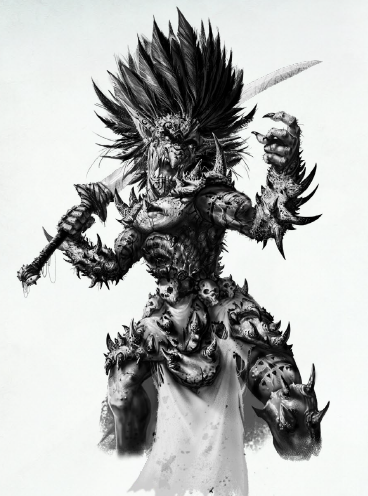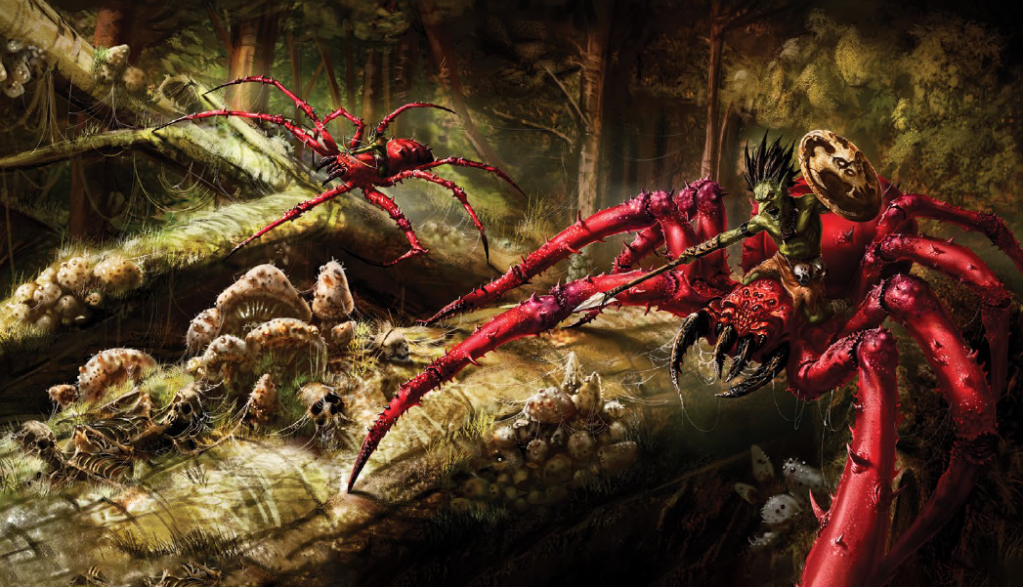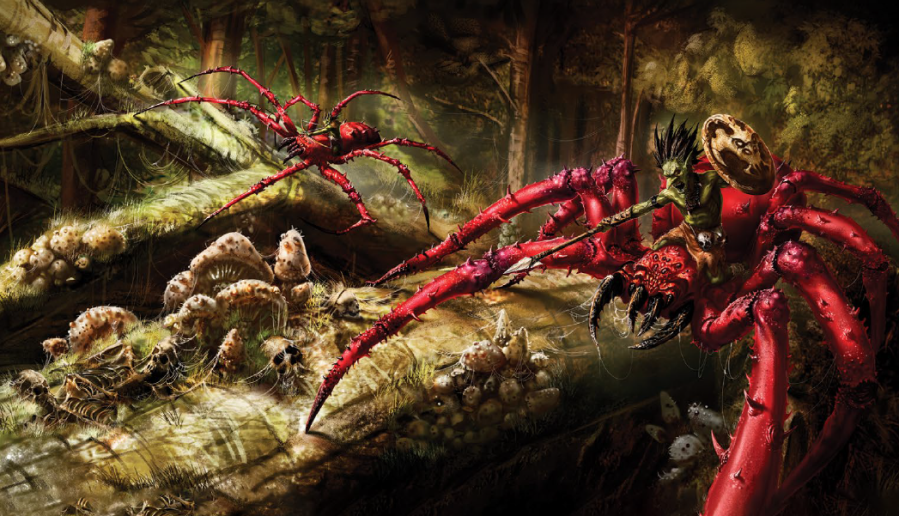A quick review this week! The Cluster-Eye Tribe is one of the short pdfs Cubicle 7 put out during the pandemic, and the first of a (so far) short series of “enemies” publications which provide lore, statistics and adventure ideas for a particular set of enemies. This one details a warband from a tribe of Forest Goblins, and it was later included in Tribes and Tribulations – a book detailing a series of such tribes, from various varieties of Greenskins (plus some Ogres and Trolls for good measure).
Judging by the introduction, this pdf is in part a reaction to the complaint that the monsters in the WFRP core rulebook are just too wimpy – unable to challenge more than very starting characters. (To be fair, the Rulebook’s Bestiary section does start with an introduction saying that these are “generic, typical starter examples of their ilk”, and encourages the GM to develop them with extra Traits, Skills and Talents. But I can fully understand why people might have missed this: it’s one paragraph at the beginning of a big chapter, and especially when you’re referring back to the Rulebook weeks or months after reading it to get the stats for a new monster, you’re unlikely to remember that brief opening paragraph. And even if you’re fully aware of this constraint, there’s an argument that the purpose of official published RPG material is to save the GM time, so you shouldn’t be having to modify baseline profiles all the time!)
In any case, The Cluster-Eye Tribe gives several “creature advancement templates”, which can be applied to base creatures to create a Soldier (generally a bit stronger and better at melee), a Skirmisher (better at ranged and stealth), and an elite (a better version of a soldier), along with leaders in the form of a Chief and Warlord template. It then goes on to present a warband made by applying these templates to the base Forest Goblin (which is just a regular Goblin for the Corebook with the Aboreal Trait) – resulting in a reasonably formidable group of adversaries. They haven’t gone crazy here: the highest Strength, for instance, is only 45 (the Chieftain), and the Elite only has a relatively modest WS of 55. Forest Goblins shouldn’t be combat monsters individually, and these ones aren’t – only the Chieftain Vish really looks like a real threat- but as a group of nearly 30 goblins, they would be very dangerous indeed to most parties. One slight gripe here is that they haven’t provided a profile for a Soldier Forest Goblin (even though the warband includes several) – its not hard to apply this template to the standard Forest Goblin profile (since it is the simplest), but it seems an odd omission.
Interestingly, the creature advancement templates are explicitly called out as being applicable not just to Goblins, but also to Orcs, Fimir, Ogres, Beastmen and Skaven. There’s nothing here that a GM couldn’t come up with herself, but it is information that could save some time.
Conspicuously missing is any Greenskin-specific magic – you have to get Tribes and Tribulations for that – but the Goblin Shaman is pretty low level so you’re not going to be throwing many spells around, and the GM is directed to theme the regular Arcane Magic spells with spiderlike qualities. (I like the Shaman’s brief backstory: he used to be really powerful but blew out half his brain through a miscast, reducing him to a very biddable shadow of his former self.)


The pdf also includes some in-universe lore on the Cluster-Eye Tribe (courtesy of Altdorf academic “Olde Weirde”, who is eventually detailed in the Altdorf sourcebook) and a bit of background from an objective perspective. I appreciate that the tribe are detailed as part of a wider ecosystem: reference is made to their rivalries with neighbouring Forest Goblin tribes as well as their friendly relationship with the Night Goblins of the Black Pit – with whom they trade captives for iron weapons, giving them an advantage over their rival Forest Goblins. It’s a little detail but it this sort of thing that makes them feel just that bit more realistic.
Also given are standard tactics for the tribe, as well as three variants of the warband, intended for use with different strengths of PC parties: a small breakaway group (easy), the warband returning from a raid with half their number dead (medium) or the full-strength warband returning from a successful raid with prisoners (hard). Interestly, the last version has a couple of fun wrinkles: firstly, the triumphant Goblins are cocksure and some members are resentful, providing dissenssion that clever PCs may be able to exploit. Secondly, they are transporting both Human and Beastmen prisoners, which may prove problematic for would-be rescuers, since bound Ungors may be hard to tell from Humans, and the Beastmen will inevitably attack them when released.
We also get three brief adventure ideas (a single page covering all of them) – such as a Dwarf asking the PCs to help her rescue her kin captured by the Tribe. I didn’t find any of these particularly exciting (one of them is basically “the PCs are suddenly confronted by a Forest Goblin scout: what do they do?”), but I think there’s enough information given in the book as a whole that you could spin the Cluster-Eye Tribe out into a full adventure if you wished. Or you could use them as a complicating factor in a larger adventure. Being Goblins they’re prone to argue amongst themselves and they’re not too bright, so its entirely possible that clever PCs could trick them into attacking a mutual enemy.

A final note is that I was very pleasantly surprised to find a page giving a summary of talents and traits for each major adversary in the Tribe (the Chieftain, Shaman, Elite and Skirmisher – once again the Soldier is missing). This is just a one-line summary of what each trait or talent they possess does – each one finishing with a “Bonus SL Summary”, showing what bonus SL they might get in different circumstances. As someone who finds WFRP 4e’s huge array of Talents and Traits pretty intimidating, this summary page looks like it would be extremely useful in play – I wish all published adventures included this for major adversaries!
So when all’s said and done, I feel quite positive about The Cluster-Eye Tribe. I had pretty low expectations of it if I’m honest, and its easily surpassed them. In particular there’s some nice information in here about the ecology of the tribe in general (useful for working out how to fit them into a campaign or adventure), as well as very decent information on potential tactics fot he Goblins to use – as well as, crucially, various weaknesses which PCs might exploit. That makes for a fun enemy – one where players can use their wits to help defeat them, not just their weapons. And it’s very reasonably priced, so you’re not risking much by checking it out.
Of course, if you want a wider selection of Greenskin (and Greenskin-adjacent) adversaries, you’re better off getting Tribes & Tribulations (which includes The Cluster Eye Tribe). I haven’t yet read or reviewed it, but I understand is this format applied to six different tribes (plus some additional material).
Buy The Cluster-Eye Tribe from DriveThruRPG. This is an affiliate link so I receive a small payment for purchases made using it.
I’ll be having a short break so the next blog post will be in a couple of weeks. Happy Easter and see you then!

Not really something that will be top priority on my purchase list.
There are after all hundreds of goblin tribes and so a whole publication dedicated to just one is a bit of a waste of ink. For the most part players take little if any interest in the culture of the greenskins they slaughter during an adventure so in that respect this publication would only really be of value if I decided to run a greenskin campaign and then I’d probably be looking for a greenskin sourcebook rather than s single tribe.
Does it even explain where goblins come from?
LikeLike
Fair enough. It’s a pretty small publication just intended to give a relatively easy option for some interesting enemies, not intended to go into any great detail about Goblin culture of anything.
LikeLiked by 1 person
”but as a group of nearly 30 goblins, they would be very dangerous indeed to most parties”
So how do you actually play that? I find that WFRP quickly becomes unplayable with more than a handful of enemies. The combat system is so complex that you really don’t want to have dozens (or even a single dozen) actors running around.
There’s a big fight of dwarves vs. goblins in Death on the Reik. In play, I wasn’t able to run it. I had to wing it a lot, basically resolving mass combat with a single roll. Our session ended a bit after the start of the fight so I took the time and ran the fight offline between sessions (the PCs were not part of the main fray). Took me at least two hours, and that was me playing alone, so it would take longer with more people.
The attack of bandits against Castle Wittgenstein I haven’t even attempted to run, and just described the result.
What I’m saying is that this supplement may be one of those that sound cool but are actually impossible to really play.
LikeLike
Yeah I think that is an issue with very crunchy combat systems like WFRP.
To be fair with the DotR bandit attack I don’t think you’re ever intended to roll dice for all the combatants – the book tells you to vaguely narrate what’s happening with combats not directly involving PCs.
With the Cluster Eye Tribe I don’t really see how you’d run a fight with the whole warband. Most of the suggested fights are with subsections of the band (or with half of them already dead from participating in a raid) which reduces the problem- though with even 15 enemies it still feels like it would take forever if you didn’t cut corners.
LikeLike
Frankly, I’d never try to run a combat with more than 10-12 participants (PC included) with the normal combat rules, in any WFRP edition. However, I have found that Ben Scerry (whom I believe was a former WFRP4 writer/editor) has written some pretty nifty mass combat rules (called “Tides of War”), which I WOULD indeed use for these (and several other) situations, and which are available for free on itch.io. The original version is for WFRP2 (https://redworldpress.itch.io/tides-of-war), but he has updated them for WFRP4 (https://redworldpress.itch.io/le-tides-of-war).
LikeLiked by 2 people
You tell me now, that I’ve finished Death on the Reik?! 🙂
Nonetheless, better late than never. Thanks a lot!
LikeLiked by 1 person
‘Archives of the Empire: Volume II’ also includes mass combat rules which would work if the PCs are unfortunate enough to encounter the entirety of the Cluster Eye Tribe.
LikeLiked by 1 person
Speaking for the Stone Snakes and Oglah Khan’s Wolfboyz in ‘Tribes and Tribulations’, I deliberately wrote them so that a group of PCs could come into contact with the entire tribe without it necessarily turning into a total blood bath. If the PCs/players act like idiots, then yes, it might turn into a mess both in terms of the practicalities of play and survivability. However, there are ways to use goblinoids, even large groups of them, where it doesn’t have to come down to a fight to the death. I’m all for a good punch-up, but it’s actually more fun to interact with goblinoids because they’re quite entertaining and it can lead to all sorts of interesting situations.
LikeLiked by 4 people
That’s good to hear, thanks!
LikeLike
@markuscz, well, you asked just today… 😉
LikeLike